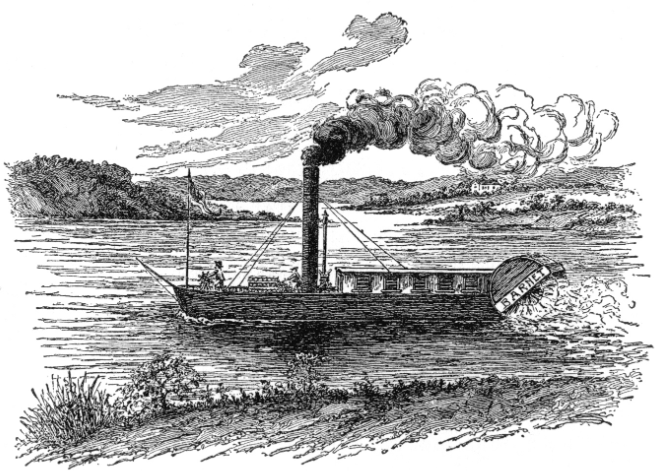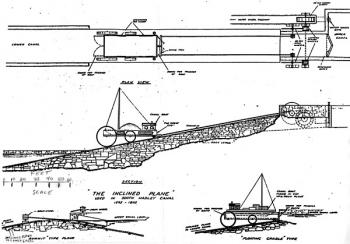Eye Witness Accounts
This page will help you work with primary sources, including a series of letters from William Lathrop. You will also have the chance to look at an account of traveling on the river by Timothy Dwight.
A. Lathrop Letters
- Read the background story. The short essay will explain the importance of the Connecticut River and how it influenced the growth of the cities and towns along its banks.
- Read the original letters below.
- Answer the questions that follow the letters.
The letters that William Lathrop wrote to his father Samuel Lathrop capture the excitement about the maiden voyage of the Steamboat Barnet.
William Lathrop was born in West Springfield and raised in one of the most prominent families of the Connecticut Valley. His grandfather, the Rev. Joseph Lathrop, who dedicated the first bridge across the river, served as minister of the First Congregational Church of West Springfield for sixty-three years.
William’s father, Samuel Lathrop, was an important state and federal political leader. He served in the Massachusetts State Senate from 1808 to 1810 and again from 1814 to 1818. He then served four successive terms in the U.S. Congress, from 1819 to 1827. After serving in Congress, he returned to the Massachusetts Senate for two more years.
The surviving letters begin in 1819 and continue through 1827, the period when Samuel Lathrop was serving in Congress in Washington, D.C. (“Washington City”). William was living in West Springfield when the Barnet made her first voyage up the river. The arrival of the Barnet at the Springfield wharf was extremely important to people all along the upper river, for they knew it meant progress and commercial expansion.
- Letter, William to Samual Lathrop, December 1, 1826
- Letter, William to Samual Lathrop, December 5, 1826
- Letter, William to Samual Lathrop, December 12, 1826
B. The Traveler’s Account
Timothy Dwight shares his experience traveling though the South Hadley Massachusetts canal system in 1823.
Your teacher will help you to understand what primary sources are, why they are important, and how to evaluate them. As you review the source, ask yourself: Who created the document and why? Why is it valuable?
- Work together to analyze The Traveler’s Account.
- Examine the two images associated with The Traveler’s Account: the incline plane and the flatboat.
- What purpose did the author of these images probably have in mind?
- What did you learn about the workings of the canal system from the sketch of the inclined plane?
- How does the image of the flatboat help you understand how it functioned for transport?
Questions to Consider:
Letter 1
- How was the Barnet’s arrival received in Springfield, Massachusetts?
- List three reasons to explain the response of the townspeople.
- Why were people curious about the Barnet? How was their curiosity satisfied?
- What did William observe by remaining on the Barnet after she docked?
- Explain how the lock and canal system works.
- How did the Barnet negotiate the locks and canals?
- Why did the Barnet go to Greenfield?
- Why does William Lathrop mention the articles that appear in the New Haven and Northampton papers? Using what you learned in The Story, why might those communities have a different opinion about the Barnet?
- How is the Barnet connected to the American System?
- How might the Barnet help the economy of the Connecticut River Valley to grow?
Letter 2
- Why was it essential for the Barnet to pass the locks further up the Connecticut River?
- Why is the speed of the steamboat significant? Is 9 mph fast or slow for transportation of this time period?
- Why might the steamboat fail?
- What is about the relationship of Brattleboro and Bellows Falls to the steamboat?
Letter 3
- How did the people of Springfield know when the Barnet had returned?
- Why did the Barnet have to anchor at Enfield?
- What product did the Barnet carry to Hartford? Which town/city had it come from?
- What particular problems did the Barnet encounter?
- How did Mr. Lyman describe the Farmington Canal? Why did he describe it that way?
- What system of transportation do the people at the dinner support? What is the evidence?
- Why was the toast to the Connecticut River and its towns important on a national scale?
- What system of transportation does Samuel Lathrop support? Use evidence from the letters to support your position
Northampton, Massachusetts,
after a Thunderstorm--
The Oxbow by Thomas Cole, 1836.
EXTENSION ACTIVITIES
The Traveler’s Accounts
- After you have worked with The Traveler’s Account and the Lathrop Letters, compare and contrast the experience of Timothy Dwight and William Lathrop
- What was the main purpose of each document? How do they differ?
- How did the audiences differ?
Read The Story and the Lathrop Letters
by Victor De Grailly
- Study the following paintings: Victor DeGrailly’s “Traveler By Oxbow” and Thomas Cole’s “The Oxbow”
- Write an essay on the pleasures and perils of being a traveler on the Barnet. Use the resources in this exhibit to describe what you see, being sure to use the paintings as a primary source. Note that DeGrailly’s painting captures a south to north vantage point, whereas Cole’s painting captures a north to southwest vantage point. Both depict the oxbow in Northampton, Massachusetts.







